Patient Stories
Lives Saved:
Michael |
Susan |
J'aime |
Kristen |
Jen |
Ryan |
Alma
Luis |
Aria |
Timena |
Lexi |
Faelan |
Taylor |
Melissa |
Kristin |
Sabuco Twins
Savanah |
David |
Meghan |
Damian |
Ashley |
Lexie |
Ron
Michael's Story
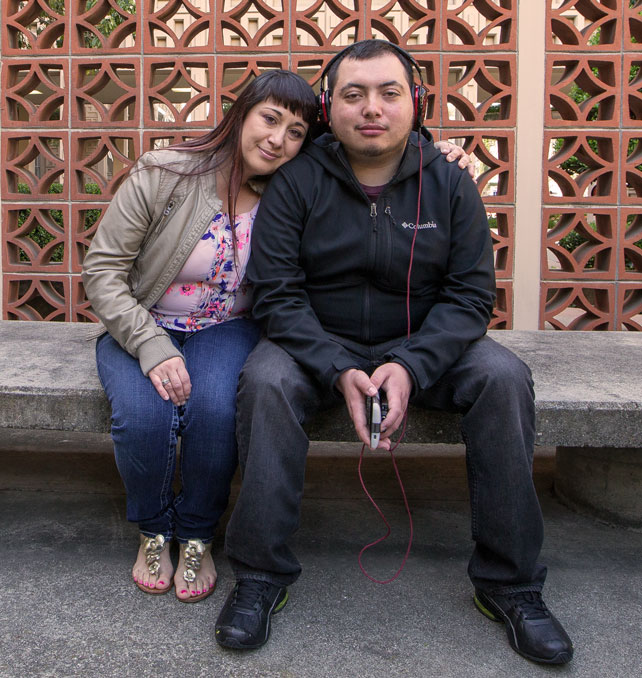
Michael with his mom, Glafira
Michael was just 20 years old when he was diagnosed with acute myeloid leukemia (AML) in 2013. What started out as what doctors thought was a bad cold, turned out to be a life-threatening and rare type of cancer that could become fatal withhin a few months if not treated. Michael and his family were in disbelief. A healthy young man up until that point, Michael had trouble absorbing the news. “I was really upset. I kept asking ‘Why is this happening to me?’ I gave up on faith,” Michael said.
Michael started receiving treatments right away, which included rounds of radiation and chemotherapy, along with blood transfusions at least once a week to keep his red blood cell count up. The next step was to wait for an HLA antigen match to be identified who could successfully donate bone marrow for a transplant.
Luckily, a few momths later, a 97% match was found and Michael underwent a successful bone marrow transplant procedure. It took some time for Michael's new bone marrow to start making white blood cells on its own, but eventually it did and Michael started to heal. Today Michael is in remission and tries to live every day to the fullest.
“We are extremely thankful that the Stanford Blood Center was there to save my son’s life,” said Glafira. Michael added, “If you donate blood, you could save a life. It could be a husband, a child, a brother, a mother — someone else’s or your own.”
Susan's Story

Susan
Susan remembers the start of her journey like it was yesterday. At the age of 22, she noticed something strange; an inflamed lymph node in her groin area. She thought she was in great health so she ignored the symptom and avoided the doctor for the next year. However, the problem persisted and was soon accompanied by a fever and constant tiredness. She finally decided to see a medical specialist.
Over the next several years, Susan saw doctor after doctor and was misdiagnosed multiple times. Then, seven years after her symptoms started and after losing 50 pounds in a month-and-a-half period, she finally saw a doctor who could see what Susan knew all along: something was very, very wrong. Susan was immediately referred to San Francisco General Hospital, where she saw an oncologist. A biopsy revealed the devastating news - Susan had non-Hodgkin's lymphoma. She was quickly referred to Stanford Hospital which, at that time, was looking for participants in their Bone Marrow Transplant program.
Susan spent the next eight months receiving chemotherapy treatments along with blood transfusions. When she was well enough, Susan was able to undergo a bone marrow transplant. After many more months in the hospital and time recovering at a Hometel, apartment accomodations on Stanford campus available to patients, she was able to go home and carry on with precious life.
Susan’s journey has been a long and painful one but she never gave up. She remembers telling her father “you taught me not to do anything I don’t want to do, and I don’t want to die.” And so, she kept fighting. She recognizes that without the generosity of blood and marrow donors, she may not have had another chance at life.
J'aime's Story

J'aime (center) with her family
In November 2011, J’aime had just finished a master’s degree in Peace Studies and was living across the world in Pristina, Kosovo when she got an unexpected email from her doctor back in California.
A few weeks earlier, before she flew to Kosovo, she had asked her doctor about some unusual bruises she had noticed. Her doctor ordered some tests just to be safe, but she never dreamed it was anything too serious. But the tests showed a very low platelet count, along with low white and red blood cell counts. Warning J’aime that this could signal a potentially life-threatening bone marrow disorder, her doctor advised her to see a blood specialist right away. She traveled to Skopje Macedonia for care, on the advice of a United Nations doctor friend. The doctor she encountered was extremely helpful and caring; he suspected aplastic anemia, and explained that if confirmed, J’aime would need a bone marrow transplant immediately.
She returned to the U.S., and it seemed as though her symptoms intensified overnight. Her doctors in the US diagnosed her with severe aplastic anemia; essentially, her bone marrow was failing to produce enough new blood cells, leading her to be susceptible to infections and bleeding. Over the next few months, she received platelet transfusions twice a week, along with other blood products that kept her going while she awaited the treatment she needed to recover: a bone marrow transplant. She was referred to the incredible transplant team at Stanford, led by Dr. Miklos and Dr. Logan, who wasted no time in searching for a donor.
The family learn the her sister Shannon was a match for J’aime, and thankfully, although it was a long road to recovery for J’aime, the transplant proved successful. Shannon has inspired other VIP blood donors too, including J’aime and Shannon’s oldest sister Carey and their brother, Chancey. When a Stanford Blood Center blood mobile showed up at Chancey’s workplace, Xilinx, he knew it was the perfect time for him to sign up and become a donor. Now, he joins his sisters in spreading the word about the importance of blood donors. J’aime says it best herself: “As much as the transplant saved my life, I would never have been able to have a transplant if not for those 49 individuals who donated blood,” she writes. Today, J’aime is healthy, happy, and determined to live life to the fullest.
Kristen's Story
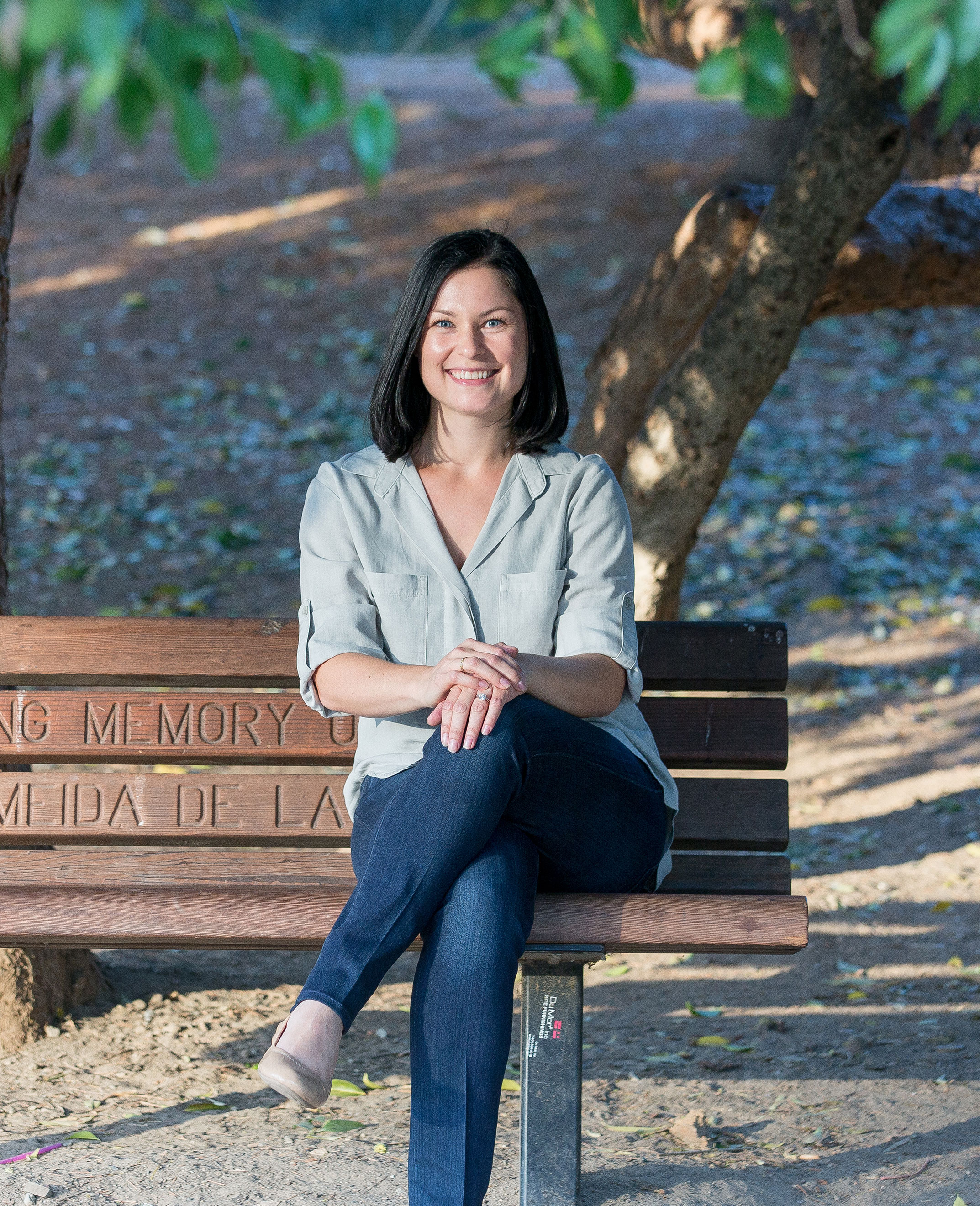
Kristen
Kristen Terlizzi was a young, healthy mother of one who was thrilled to be pregnant with her second child. The pregnancy was going seemingly well and Kristen felt great but at 29 weeks an ultrasound revealed evidence of placenta accreta.
Placenta accreta is a condition during pregnancy in which the placenta attaches too deeply to the uterine wall in varying degrees. Kristen suffered from the most severe form, called precreta, wherein the placenta grows through the uterine wall and invades surrounding organs.
Despite the extensive preparations made by Kristen and her medical team, doctors were surprised during the delivery how extensive the invasion of the placenta was. In an unprecedented move, they decided to deliver the baby but leave the placenta inside her body while they evaluated the situation. Ultimately, doctors delivered the placenta and uterus during an emergency surgery lasting 8 hours and requiring Kristen receive 26 units of blood.
Kristen thinks about the donors whose blood was available to save her life that day and is forever grateful. "I consider those donors just as important to my outcome as the many doctors and nurses in the operating room that day. Without that blood, my story would have a much different ending.” Kristen said.
Jen's Story
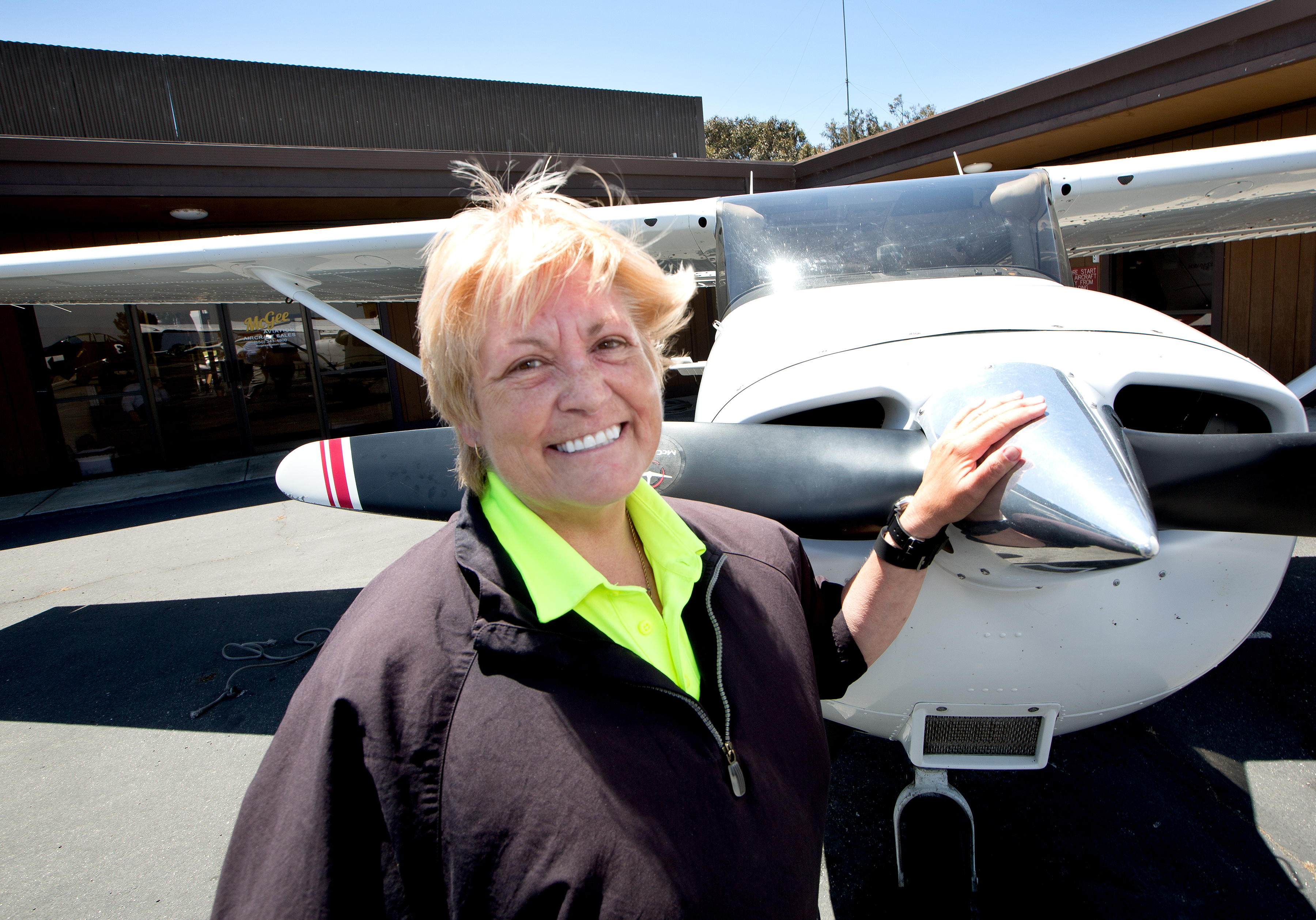
Jen
Jen Julian, 57, might be the most active person you will ever meet. She golfs, skis, bikes, boats, scuba dives, hikes and regularly makes good use of her newly granted pilot’s license. She is without a doubt the epitome of what life can be when given a second chance.
In 2006, Jen became the recipient of a double lung transplant. Even after what was considered a successful surgery, Jen was told it wasn’t likely she would ever be able to do the things she loved anymore. Months would pass before she regained her strength but through her incredible spirit and resolve, she persevered. Only six months after her transplant, and with permission from her doctors, she was skiing at 7,800 feet.
This July 2015, Jen will be celebrating the nine-year anniversary of her lifesaving procedure performed at Stanford University Medical Center. Since then, she has dived in some of the most famous bodies of water in the world. She has also started golfing again and even brought home a gold medal from the Transplant Games competition.How many people will ever get the proverbial second chance at life? If your name is Jen Julian, you recognize how rarely those chances are given and remind yourself by making the most of every single day. For that reason, Jen says she prefers to describe herself as a “thriver” as opposed to a “survivor.”
"Every day I wake up I’m reminded life is amazing,” said Jen. “The first deep breath I take is for my donor, and the next one reminds me to live the day to the fullest.”
Ryan's Story

Ryan
On one fateful day in 2004, motorcycle enthusiast and Stanford Video employee, Ryan Roberts decided to ride his motorcyle to work when he was called in over the Fourth of July weekend. This decision would change Ryan's life forever.
Riding on the freeway to work, Ryan thinks he must've hit something in the road which threw him off course and into the guardrail. He remembers thinking "That guardrail is getting close, I am not going to be able to get out of this," before his bike started to wobble and he was down. He tried to stand but his leg was up by his shoulder.
Ryan suffered severe injuries, including an amputated leg, and lost apporiximately 80% of his blood that day. Thankfully, several people stopped to help, one happened to be an off-duty fireman and another a nurse on her way to work at Stanford Hospital. Thanks to the courage of these bystanders, and the blood donors that contributed to SBC having blood on the shelves when Ryan needed it, he survived.
“I'm forever thankful for the people who donated blood. I wouldn't be here today without them.” said Ryan.
Ryan spent several weeks recovering and still has two steel plates in his arm and a prosthetic leg but has worked hard to overcome the challenges of his new reality. He is still with Stanford Video and is now married with two beautiful children. Ryan hopes that his story will help inspire others to donate blood.
Alma's Story

Alma
On June 10, 2014, after a long and complicated labor, baby Alma's journey began. At her two month pediatric appointment, she was diagnosed with Biliary Atresia, a chronic liver disease that is life threatening.
Doctors knew that had to work quickly to give Alma the best chance of survival so they conducted a Kasai portoenterostomy immediately but when that procedure was not successful, they rushed Alma to Lucille Packard Children's Hospital Stanford (LPCH) where she was stabilized and put on the pediatric liver transplant list.
Several months later, a liver was finally found for Alma and the transplant procedure took place. During the surgery, Alma received a full blood transfusion because she had an ABO mismatch liver. But the procedure was successful and the family is now back home in Portland, Oregon and Alma is happy and healthy.
"Every day is Christmas Day when I see her smiling and growing stong," said Alma's mom Amy.
Luis's Story

Luis
Almost 20 years ago, Luis was water skiing with friends when the boat that was towing him unexpectedly reversed and the propeller caught Luis, damaging his right leg and abdomen. Since then the accident has led to other serious health complications such as liver damage.
Last year, Luis’ family noticed he was losing weight quickly and unable to absorb nutrients. Doctors decided to put him on a strict regimen of Total Parenteral Nutrition (TPN) or tube feedings. Unfortunately, liver damage is also a common side effect of TPN and in November 2014 he was admitted to Stanford University Medical Center, hoping to receive a liver transplant. Due to the severity of his illness, Luis moved up the transplant priority list quickly.
Over Christmastime Luis’ health rapidly declined until eventually he needed a transplant as soon as possible. Waiting for a proper organ match made days feel like years. Miraculously, on December 28 a match was found and three months after his surgery Luis was home and on the road to recovery. His body has adapted to the transplant very well and without any complications. Doctors have said Luis’ blood work looks great and he is currently in physical therapy working on regaining his strength.
Luis’ family wants everyone to know how important blood donation is so they decided to give back by doubling a surprise birthday party for him with a blood drive. “It’s hard to understand until you’re put in a position where someone you love needs blood,” said Luis’ daughter, Anais. “There were countless times we wished we could give him part of our health, a healthy liver, anything to make him better.“
“We will forever be thankful to those SBC donors who donated the blood that our father received, ” shared Gabriela Navarro, Luis’ oldest daughter.
Aria's Story

Aria Photo by Norbert van der Groeben
Aria was born with Diamond Blackfan Anemia (DBA), a rare blood disorder that - in addition to severe anemia - is associated with birth defects and/or other abnormal features.
When Aria was delivered seven weeks early via an emergency cesarean section, she only weighed 3 lbs. 3 oz. At two months old, Aria received her first blood transfusion because she was unable to produce her own healthy red blood cells. Over the next six months, she received several more transfusions as doctors struggled to identify the cause of her anemia. Finally, they were able to diagnose Aria with DBA.
Since her initial treatment, Aria’s visits to the hospital have reduced significantly and she continues to grow and thrive. Because of her rare blood disease, Aria has received many units of blood from generous donors that sustained her health; these units also provided doctors with the tools to diagnose her condition.
“I am so thankful for blood donors because without them Aria wouldn’t have been diagnosed and most likely wouldn’t have survived!” her mother said.
Timena's Story

Timena Photo by Norbert van der Groeben
As a child, Timena was a sporty and energetic soccer devotee. But by age 12, persistent shortness of breath forced her to give up the sport she loves. By age 17, her concerned family took her to a doctor, as she was losing a lot of weight and frequently seemed feverish. The doctor delivered surprising news: Timena likely had rheumatic fever when she was younger.
In Timena’s case, the infection was mild enough to slip under the radar, but it most likely damaged her heart. Her doctors detected a heart murmur and further tests revealed she was in grave danger: one of her heart valves was leaking.
Doctors acted immediately and Timena underwent two heart valve surgeries at Lucile Packard Children’s Hospital Stanford, where she needed blood transfusions to get her through the surgery.
Timena is now truly on the path to recovery and is grateful for all of the care and support she received from hospital staff, friends and family. “It was tough but I’m really blessed,” she said. “I’m thankful and looking forward to my life ahead of me.”
Lexi's Story

Lexi Photo by Norbert van der Groeben
Lexi was diagnosed with sickle cell anemia as an infant. It’s a life-threatening illness in which red blood cells become sickle-shaped instead of spherical. These cells can get stuck in small blood vessels, blocking blood flow and oxygen to other parts of the body. At age 5, a routine test came back as abnormal and doctors discovered that the blood vessels in Lexi’s brain were narrowing. In an attempt to stabilize the vessels and lessen her chance of stroke, she began receiving blood transfusions every 3-4 weeks.
Things were going well until 2011, when Lexi started having transient ischemic attacks, or mini strokes. After an MRI, she was diagnosed with moyamoya, a rare vascular disease that causes the arteries in the brain to narrow progressively until they eventually close. She would undergo an extracranial to intracranial bypass surgery on the left side of her brain to increase blood flow. She continues to receive red blood cell transfusions every six weeks.
“Blood donors have blessed me to be able to do so many of my hobbies, such as dance and gymnastics,” Lexi says. “I can’t thank blood donors enough for helping me achieve my goals.”
Faelan's Story

Faelan plays in his backyard Photo by Norbert van der Groeben)
Faelan has hereditary spherocytosis, which causes his red blood cells to be fragile and spherical in shape, instead of the normal donut shape. His red blood cells live a shorter life, and the spleen becomes enlarged as it attacks the red blood cells. As a result, Faelan is anemic and becomes tired easily.
Many common viral infections, such as parvovirus, can dramatically lower his red blood cell production and lead to an aplastic crisis, when the bone marrow stops producing red blood cells — resulting in sudden, severe anemia. When this happens, Faelan becomes as limp as a rag doll, pale as a ghost, and hard to wake. Several times, Faelan has needed emergency transfusions that literally saved his life. His mother says that the bag of blood is like a battery, charging him right up! Faelan’s parents feel very blessed because they know it could be a lot worse and it’s very manageable — but it’s only manageable because caring strangers donated blood to give to children like Faelan.
Taylor's Story
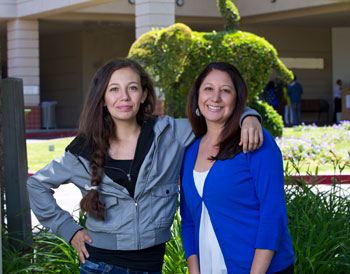
Taylor and her mother, Lori Photo by Norbert van der Groeben
Taylor, age 15, has a rare illness that required blood transfusions and a kidney transplant. Taylor’s mom, Lori, was her kidney donor but blood donors also played a vital role in her recovery. Taylor has a message to the blood donors who helped save her life. “Thank you! I lost a lot of blood.”
Lori is also grateful for the life-saving gift blood donors gave her daughter and encourages others to give as well. “A very small donation can mean the world to someone else in dire need.”
Melissa's Story
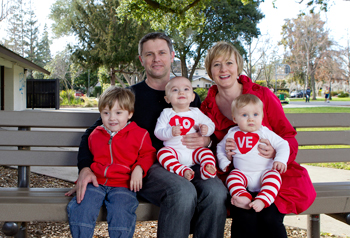
Melissa and family.
"It cannot be a coincidence that World Blood Donor Day is June 14. The same day my life was saved by donated blood. Amazing!"
-Melissa Price
On June 6, 2011, Melissa and her husband, Tim, and 3-year-old son, Flynn, welcomed twin boys, Keane and Hayes, into their family. Melissa's pregnancy and delivery had been normal. The twins were healthy and together weighed over 14 pounds which is considered big for twins. After a typical recovery period, Melissa went home to care for her family. "To me, my family was perfect and complete," she said.
However, eight days after the birth, Melissa began to hemorrhage at home while getting ready to take the twins to see their pediatrician. Melissa's mom drove her to Stanford Hospital. At her insistence, Tim took the twins to their appointment while Flynn played at the park with his nanny.
At Stanford, the bleeding was unstoppable. Melissa was rushed to the operating room. She woke up five hours later in agony and confused. "Turns out, things went from bad to worse to way worse in the operating room. My doctor performed an emergency surgery to save my life," said Melissa.
Melissa had lost two liters of blood. During the surgery, she was given four units of red blood cells and several units of additional blood products. The next day, her doctor ordered two more units of red blood cells at her bedside. It was transfused while she lay awake thinking about the people who had donated blood for her. "Because of blood donors, I am alive," she thought. "True, my doctor made life-saving decisions, but in the end what I needed to survive was blood. And thanks to complete strangers, my children have their mom."
Kristin's Story
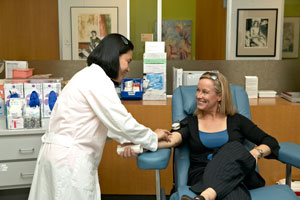
Kristin at Hillview Center
The importance of blood donation wasn’t lost on Kristin. In fact, she had been a blood donor almost all of her adult life, when the tables were turned on her in 1994. Suddenly, Kristin wound up on the other side. During an emergency medical situation, she received six units of O-negative blood over the course of 24 hours. “That’s a lot of blood,” she said. “I’m so grateful that it was there for me.”
Forever appreciative of the unknown donors who made her transfusions possible, Kristin now donates regularly at Stanford Blood Center.
Conjoined Twins Angelica and Angelina Sabuco
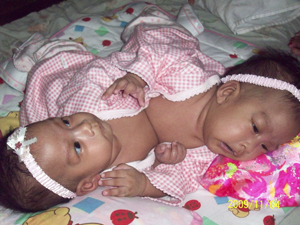
Angelica and Angelina at 3 months old
Stanford Blood Center donors helped support the successful surgery that separated conjoined twins, Angelica and Angelina Sabuco, at Lucile Packard Children's Hospital on Nov. 1, 2011. The surgery that took nearly 10 hours required the two-year-old girls to receive approximately 10 units of blood.
"We are so grateful to the medical team and selfless blood donors who made Angelica and Angelina's separation possible," said mother Ginady Sabuco. "Please give blood so that other patients have it available when they need it too."
For more information about Angelica and Angelina and the separation surgery, click here.

Angelina, Ginady, Vincent, Angelica and Fidel Sabuco
Healing and Growing: Savanah's Story

Savanah
Shortly after her second birthday, Savanah began making frequent trips to her mother's room at night, complaining that her tummy ached. Her mother, Carine, wondered if the tummy aches weren't actually Savanah's attempt to gain a little extra attention. Carine did think it strange, however, that when Savanah said her tummy hurt, she was pointing or pulling on her chest and not her "tummy."
Savanah's complaints persisted and one night, Carine placed her hand on Savanah's torso and was surprised about how hot it was, even though Savannah did not have a fever.
Carine decided to bring Savanah in to her pediatrician for a checkup. The routine blood tests and examination revealed nothing. Despite the test results, Savanah's doctor was very concerned about Savanah's swollen and warm abdomen and ordered a CT scan. The scan clearly showed a mass in Savanah's tiny body. She was quickly admitted to a local hospital where a bone marrow and other tests revealed that Savanah suffered from neuroblastoma — a rare cancer that usually affects very young children.
Savanah's family was devastated by the news, and scrambled to bring her up to Lucile Packard Children's Hospital at Stanford from their home in Bakersfield. Since arriving in September 2006, the family has stayed at Ronald McDonald House (RMDH) while Savanah receives treatment. "The House has become our second home," remarks Carine. While at RMDH, Savanah has charmed many with her bright smile and cheerful personality. "Savanah's a very outgoing and talkative little girl. She's grown so much and has come so far," adds Carine.
Savanah's initial treatment consisted of several months of chemotherapy intended to shrink the 15 cm wide tumor growing inside her tiny body. To counteract the damaging effects of the intense chemotherapy, Savanah received many life-saving blood transfusions that bolstered her weak blood supply. "I'm so very grateful for the blood that helped Savanah. If there were no blood donors, I doubt Savanah would still be with us," says Carine.
Finally, in January 2007, chemotherapy had shrunk the tumor in Savanah's abdomen from 15 to 7 cm. Surgery was scheduled and a team of doctors operated for hours to remove the mass. Savanah's doctor is optimistic that the operation was successful. Despite the surgery, Savanah must still endure yet another difficult treatment. This March, Savanah will undergo a stem cell transplant at LPCH — a procedure that will require a lengthy hospital stay followed by a 100-day isolation period at RMDH. This treatment will almost certainly require additional transfusions of blood.
David's Story

David and his mother Aimee play at Ronald McDonald House in Palo Alto
Two-year-old David McNally, a bright and energetic toddler, was diagnosed shortly before his first birthday with Wiskott-Aldrich syndrome (WAS), a rare disorder of the immune system. WAS results in abnormal functioning of the cells that fight off infections, and causes the body to produce defective platelets, leaving David susceptible to infections and bleeding.
At one-and-a-half-years, David suffered a severe brain hemmorhage resulting from a trampoline accident. Several platelet transfusions were required in order to stop the internal bleeding. "Simply put, donated platelets saved David's life," explains his mother, Aimee.
In an effort to repair his damaged immune system, David received a bone marrow transplant at Lucile Packard Children's Hospital in August 2006. As part of his treatment, David received numerous blood products while recovering from the procedure. His parents kept a constant vigil during the difficult 40 day stay in the hospital—a physically and emotionally exhausting labor of love.
Once well enough to leave the hosptial, David and his mother began their post-transplant 100 day stay at Ronald McDonald House. He and his mother shared a suite at the house's Immune Garden Wing—a specialized area designed to keep children receiving treatment for diseases that affect the immune system healthy while they recover.
In addition to providing a clean environment where David can regain his strength, Ronald McDonald House also offers David and his mom more "living room." David takes full advantage of the house's spacious indoor and outdoor play areas, and is happy to have other children to play with. Aimee especially enjoys being able to cook their own meals and connect with other families staying at the house. For Aimee, Ronald McDonald House has provided a much-needed supportive community that she is convinced contributes to David's recovery and her own sense of well-being. "Here at the house, we all have each other to rely upon and share our experiences with. This support is instrumental, especially given that most of us only see other members of our family on weekends."
According to his mother, David is doing just fine and acting more like a toddler everyday. The two look forward to returning home sometime in January 2007.
Meghan's Story

Meghan underwent daily plasma exchanges during treatment
Meghan was completely dependent upon machines for her survival... She had a rare and life-threatening blood disease known as TTP/HUS (Thrombocytopenic Purpura or Hemolytic Uremic Syndrome). This meant she was bleeding internally. The disease destroyed her red blood cells, and shards of the cells ended up in her plasma, consequently clogging her kidneys. She needed daily plasma exchanges.
The plasma pheresis treatments she received took an average of an hour and a half a day, and she used an estimated 17 units of donated plasma each day she was in the hospital. She also endured rounds of chemotherapy and numerous blood transfusions. She received 987 units of blood products.

Meghan in Santa Barbara after her recovery.
"Thanks to my family's tremendous love and support, my friends' constant encouragement, and the many anonymous donors whose blood saved my life, I was able to graduate from college with my class despite taking a semester off," Meghan said. Currently, she works full-time and is not hindered by any remaining effects of her illness.
"If 987 strangers had not donated blood, my story would be a different one. We are all so thankful that it was there for me."
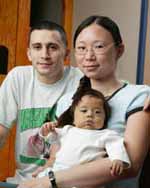
Damian
Damian's Story
Matt is a member of the U.S. Armed Services and is stationed in Okinawa, Japan. When his son, Damian, needed surgery they came to Lucile Packard Children’s Hospital. Matt and his wife, Meelee, stayed at the Ronald McDonald House while Damian had a Kasai operation, a surgical procedure that creates a drainage system for bile by connecting the intestine directly to the liver. It is used for an abnormality called biliary atresia in which some or all of the normal bile drainage system is absent. Weighing only seven pounds, Damian used two units of blood during the life-saving operation. “It was nice to know that the blood was there,” said Matt.
“Without blood transfusions, he would not have been able to pull through,” Meelee said. “It saved his life.”
Ashley's Story
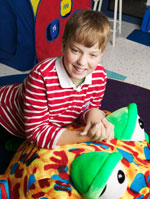
Ashley
You would never know by looking at Ashley that just a year prior she’d had a kidney transplant operation that saved her life. Ashley had been on dialysis for three years before the call came that a kidney was available. Type-O blood transfusions helped her get through the surgery and a one-hundred-day stay at the Ronald McDonald House kept her near Lucile Packard Children’s Hospital for treatment while she recovered. Ashley’s dad, Jay, is a regular blood donor, and is grateful to all those who have helped Ashley get healthy again.
Lexie's Story

Lexie and Mom
At only 5-months-old, Lexie needed six units of blood during a nine-hour liver transplant operation that saved her life. Doctors at Lucile Packard Children's Hospital expect Lexie to grow up healthy and happy thanks, in part, to the blood donors that saved her life. "Both the family that donated an organ and the people who donated blood saved her life," explained her mother, Wendy.
Ron's Story

Ron
Ron needed hundreds of units of blood to stay alive during his successful battle with leukemia at Stanford Hospital. In October 2000, Ron underwent a bone marrow transplant (BMT) and had to be hospitalized and kept in a quarantined room for two-months. Ron received many platelet transfusions. "I never knew it took so much blood to keep people alive in the BMT area. It's staggering to know I was there for 10 months getting blood products, sometimes daily."
